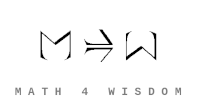- MathNotebook
- MathConcepts
- StudyMath
- Geometry
- Logic
- Bott periodicity
- CategoryTheory
- FieldWithOneElement
- MathDiscovery
- Math Connections
Epistemology
- m a t h 4 w i s d o m - g m a i l
- +370 607 27 665
- My work is in the Public Domain for all to share freely.
- 读物 书 影片 维基百科
Introduction E9F5FC
Questions FFFFC0
Software
Bott periodicity, Bott periodicity models divisions
Readings
- Andrzej Trautman. On Complex Structures in Physics. Baez discusses this. Trautman relates Clifford algebra clock, spinors and charge conjugation.
Ideas
Linear complex structure
- Assignment is asymmetric (computer science), equality is symmetric (math). Compare this with linear complex structure.
- The linear complex structure {$ \begin{pmatrix}0 & -1\\1 & 0 \\ \end{pmatrix}$} squares to {$-1$} and has order {$4$} and models the conscious outlook. Whereas its counterpart in the representation of {$CT$}-groups is odd antilinear {$ \begin{pmatrix}0 & 1\\1 & 0 \\ \end{pmatrix}$}, squares to {$1$}, and models the unconscious outlook.
- Orthogonality appears in Bott periodicity. Linear complex structures are orthogonal skew-symmetric matrices (for which {$j^T=-j$} so that together {$j^{-1}=-j=j^T$}. My approach to the wave function is based on orthogonal Sheffer polynomials.
Linear complex structures as a sequence
- {$J_1$} is a linear complex structure which models the unconscious, adding a perspective {$+1$}. {$J_2$} adds an antilinear operator which models reflection and a perspective on a perspective. Together they yield the conscious. {$J_3$} divides the space on which these act into two parallel spaces, thus is a perspective upon a perspective on a perspective. Together they are consciousness. {$J_3J_4$} defines an isometry between the two spaces.
Linear complex structures
The inverse of an orthogonal matrix is given by its transpose.
{$J_1=\begin{pmatrix} 0 & -1 \\ 1 & 0 \\ \end{pmatrix}\equiv i$}
{$J_2=\begin{pmatrix} 0 & 0 & 1 & 0 \\ 0 & 0 & 0 & -1 \\ -1 & 0 & 0 & 0 \\ 0 & 1 & 0 & 0 \\ \end{pmatrix}\equiv \begin{pmatrix} 0 & \varphi \\ -\varphi & 0 \\ \end{pmatrix}$}
{$J_1J_2=\begin{pmatrix} i & 0 \\ 0 & i \\ \end{pmatrix}\begin{pmatrix} 0 & \varphi \\ -\varphi & 0 \\ \end{pmatrix} = \begin{pmatrix} 0 & i\varphi \\ -i\varphi & 0 \\ \end{pmatrix}=\alpha$}
{$I_1J_1J_2=\begin{pmatrix} I & 0 & 0 & 0 \\ 0 & I & 0 & 0 \\ 0 & 0 & -I & 0 \\ 0 & 0 & 0 & -I \\ \end{pmatrix}\begin{pmatrix} 0 & i\varphi & 0 & 0 \\ -i\varphi & 0 & 0 & 0 \\ 0 & 0 & 0 & i\varphi \\ 0 & 0 & -i\varphi & 0 \\ \end{pmatrix}=\begin{pmatrix} 0 & i\varphi & 0 & 0 \\ -i\varphi & 0 & 0 & 0 \\ 0 & 0 & 0 & -i\varphi \\ 0 & 0 & i\varphi & 0 \\ \end{pmatrix}$}
{$J_3=(I_1J_1J_2)^{-1}=\begin{pmatrix} 0 & -i\varphi & 0 & 0 \\ i\varphi & 0 & 0 & 0 \\ 0 & 0 & 0 & i\varphi \\ 0 & 0 & -i\varphi & 0 \\ \end{pmatrix}\Rightarrow \begin{pmatrix} 0 & -i\varphi \\ i\varphi & 0 \\ \end{pmatrix}$}
{$LJ_3=\begin{pmatrix} 0 & 0 & 1 & 0 \\ 0 & 0 & 0 & 1 \\ 1 & 0 & 0 & 0 \\ 0 & 1 & 0 & 0 \\ \end{pmatrix}\begin{pmatrix} 0 & -i\varphi & 0 & 0 \\ i\varphi & 0 & 0 & 0 \\ 0 & 0 & 0 & i\varphi \\ 0 & 0 & -i\varphi & 0 \\ \end{pmatrix} = \begin{pmatrix} 0 & 0 & 0 & i\varphi \\ 0 & 0 & -i\varphi & 0 \\ 0 & -i\varphi & 0 & 0 \\ i\varphi & 0 & 0 & 0 \\ \end{pmatrix}$}
{$J_4=(LJ_3)^{-1}=\begin{pmatrix} 0 & 0 & 0 & -i\varphi \\ 0 & 0 & i\varphi & 0 \\ 0 & i\varphi & 0 & 0 \\ -i\varphi & 0 & 0 & 0 \\ \end{pmatrix}$}
{$J_\gamma=\begin{pmatrix} 0 & -1 \\ 1 & 0 \\ \end{pmatrix}=i$}
{$\begin{pmatrix} 0 & 1 \\ 1 & 0 \\ \end{pmatrix}\begin{pmatrix} v_+ \\ v_- \\ \end{pmatrix} = \begin{pmatrix} v_- \\ v_+ \\ \end{pmatrix}$} is the form of an isometry {$L_\beta$} between two vector subspaces.
{$\begin{pmatrix} 1 & 0 \\ 0 & -1 \\ \end{pmatrix}\begin{pmatrix} v_+ \\ v_- \\ \end{pmatrix} = \begin{pmatrix} v_+ \\ -v_- \\ \end{pmatrix}$} is a nontrivial antilinear operator {$I_\alpha$} that squares to {$+1$}.
{$\begin{pmatrix} 0 & -1 \\ 1 & 0 \\ \end{pmatrix}\begin{pmatrix} 1 & 0 \\ 0 & -1 \\ \end{pmatrix}=\begin{pmatrix} 0 & 1 \\ 1 & 0 \\ \end{pmatrix}$}
Suppose we have a linear operator that squares to {$+1$}. What does that look like?
